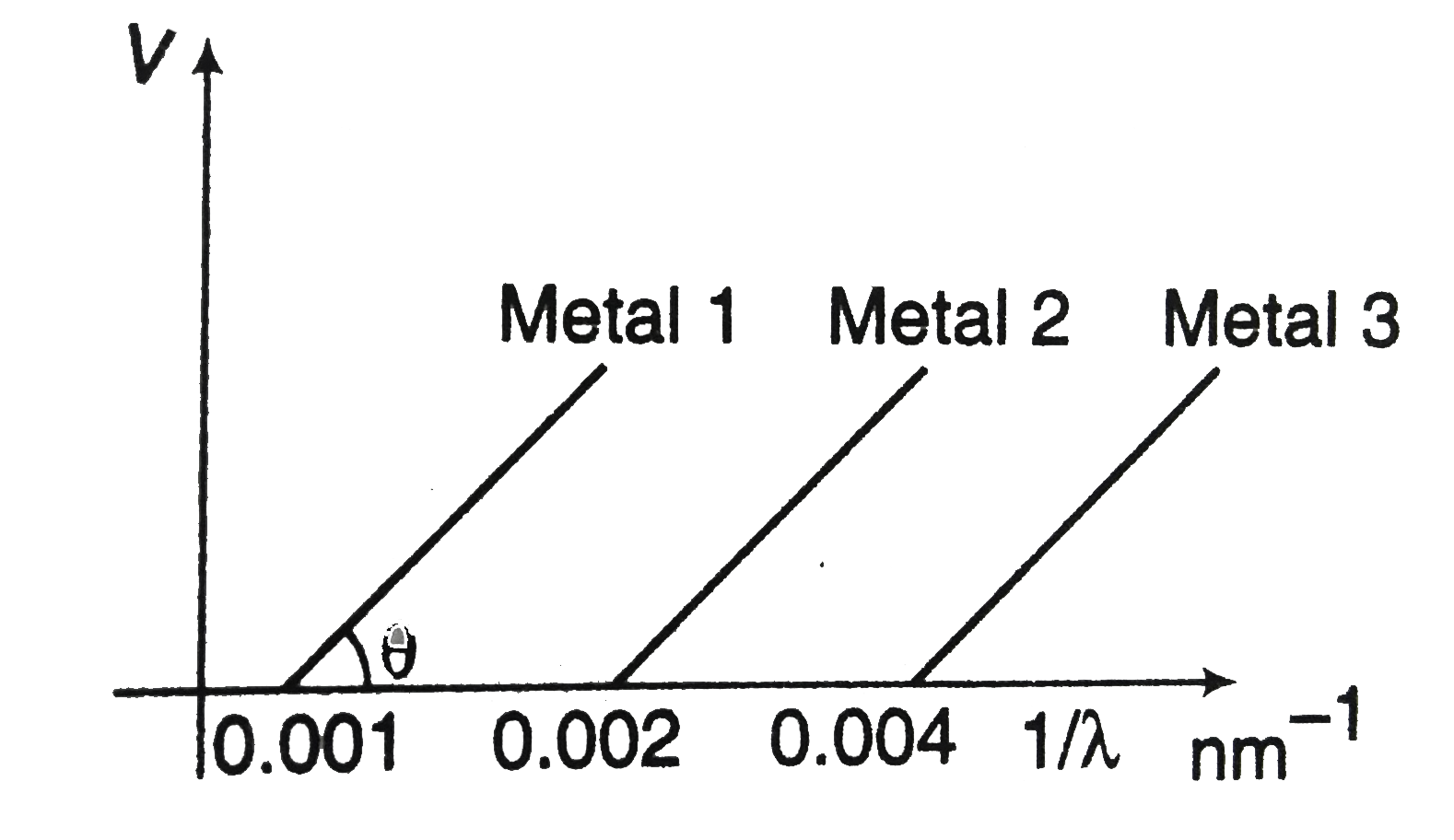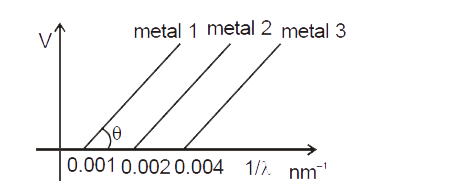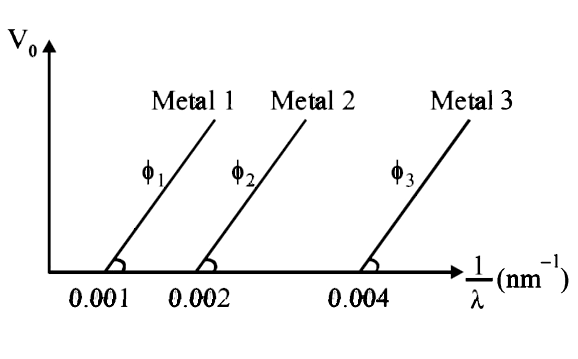The graph between 1/λ and stopping potential (V) of three metals having work- functions Φ1, Φ2 and Φ3 in an experiment of photoelectric effect is plotted as shown in the figure. Which of the following statement(s) is/are correct? (Here, λ is the wavelength of the incident ray). (a) Ratio of work functions ϕ1:ϕ2:ϕ3=1:2:4 (b) Ratio of work functions ϕ1:ϕ2:ϕ3=4:2:1 (c ) tan θ is directly proportional to hc / e, where h is Planck constant and c is the speed of light (d) The violet colour light can eject photoelectrons from metals 2 and 3 .

Ratio of work function, ϕ1:ϕ2:ϕ3=1:2:4
Ratio of work function, ϕ1:ϕ2:ϕ3=4:2:1
tanθ is directely proportional to hc/e where h is planck's costant and c is the speed of light
The violet colour light can eject photoelectrons form metals 2 and 3
The correct Answer is:a,c
From Einstein's photoelectrons equation
K.E.=eV=hcλ−ϕ...........(i)
or V=hceλ−ϕe......(ii)
When λ=λ0, the threshold wavelength, K.E.=0.
From (i), ϕ=hcλ0 or ϕhc=1λ0
For plate1,ϕ1hc=0.001,
For plate2,ϕ2hc=0.002,
For plate3,ϕ3hc=0.004,
∴ϕ1:ϕ2:ϕ3=1:2:4
Differetiating (ii), we get
ΔV=hceΔ(1/λ) or ΔVΔ(1/λ)=hce
Slope of the graph, tanθ=ΔVΔ(1/λ)=−hce
For plate 2, threshold wavelength,
λ02=hcϕ2=hc0.002hc=500nm
For plate 3, threshold wavelength,
λ03=hcϕ3=hc0.004hc=250nm
since the wavelength of violet colour is 400nm and λviolet<λ02 for plate 2 and λviolet>λ0for plate 3, therefore, violet colour light will ejected electrons from plate 2 and not plate 3.
Topper's Solved these Questions
- BOOK - PRADEEPCHAPTER - DUAL NATURE OF RADIATION AND MATTEREXERCISE - Value based question1videos
DUAL NATURE OF RADIATION AND MATTER
- BOOK - PRADEEPCHAPTER - CURRENT ELECTRICITYEXERCISE - Problems for Practice (B)2videos
CURRENT ELECTRICITY
- BOOK - PRADEEPCHAPTER - ELECTROMAGNETIC INDUCTION & ALTERNATING CURRENTEXERCISE - Multiple Choice Questions1videos
ELECTROMAGNETIC INDUCTION & ALTERNATING CURRENT
Similar Questions
The graph between 1/λ and stopping potential ( V ) of three metals having work functions ϕ1,ϕ2 and ϕ3 in an experiment of photoelectric effect is plotted as shwon in the figure. Which of the following statement (s) is / are correct ? [Here λ is the wavelength of incident ray ].
 View Solution
View SolutionThe graph between 1λ and stopping potential V0 of two metals having work funcation ϕ1 and ϕ2 in an experiment of photoelectric effect is obtained as shown in the figure. Find out -
_E01_164_Q01.png)
(i) Threshold wavelength ofboth metals
(ii) ϕ1:ϕ2
(iii) Whihc metal cen emit photoelectrons with visible light ?View Solution
Knowledge Check
- Question 1 - Select One
For a photocell, the work function is ϕ and the stopping potential is Vs . The wavelength of the incident radiation is
AhcϕBhcϕ−eVsChcϕ+eVsDhceϕ+Vs - Question 2 - Select One or More
The graph between the stopping potential (V0)and(1λ) is shown in the figure ϕ1,ϕ2andϕ3 are work function , which of the following is //are correct
 Aϕ1:ϕ2:ϕ3=1:2:4Bϕ1:ϕ2:ϕ3=4:2:1Ctanθ∝hc€Dultravioletight can be used emit photoelectrons from metal 2 and 3only
Aϕ1:ϕ2:ϕ3=1:2:4Bϕ1:ϕ2:ϕ3=4:2:1Ctanθ∝hc€Dultravioletight can be used emit photoelectrons from metal 2 and 3only - Question 3 - Select One or More
A beam of ligth having frequency v is incident on an initially neutral metal or work function ϕ(hv>ϕ). Then
Aall emitted photoelectrons have kinetic energy equal to (hv>ϕ)Ball free electrons in the metal, that absorb photons of energy hv completely, may not be ejected out of the metal.Cafter being emitted out of the metal, the kinetic energy of photoelectrons decreases continuously as long as they are at a finite distance from metal .Dthe emitted photo electrons move with constant speed after escaping from the electric field of metal.
If A={ϕ,{ϕ},1.{1,ϕ},7}, then Which of the following are true ?
View SolutionLet A={ϕ{ϕ},1,{1,ϕ},2}. Determine which of the following is true or fase.
View SolutionConsider the following statements
I. ϕ∈{ϕ} II. {ϕ}⊆ϕ Which of the statements given above is/are Correct?View SolutionThe work function (ϕ) of some metals is listed below. The number of metals which will show photoelectric effect when light of 300 nm wavelength falls on the metals is :
 View Solution
View SolutionA light of 4eV incident on metal surface of work function ϕeV . Another light of 2.5eV incident on another metal surface of work function ϕ2eV . Find the ratio of maximum velocity of photo electrons (v1v2).
View Solution

